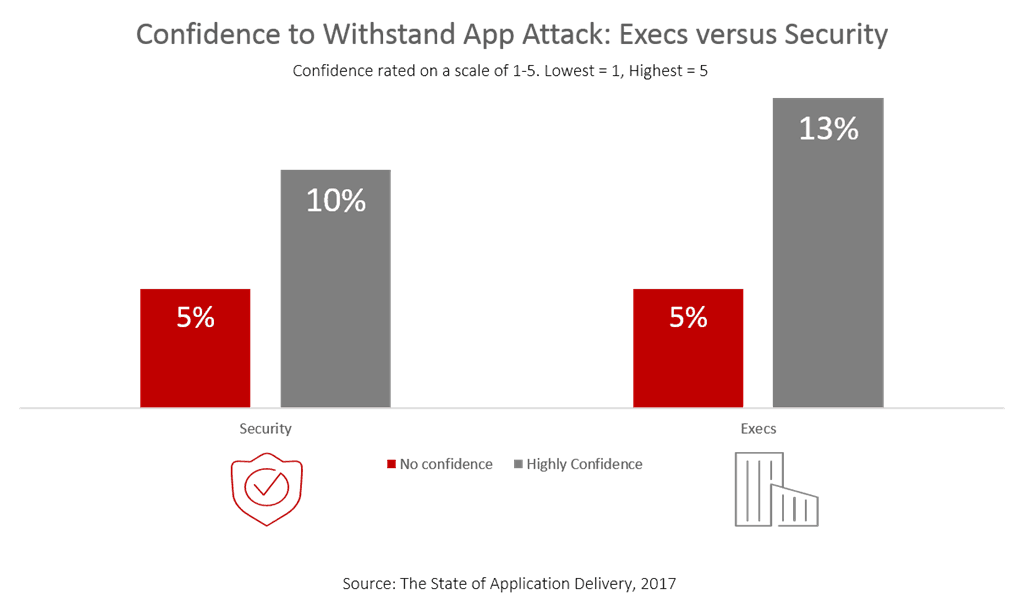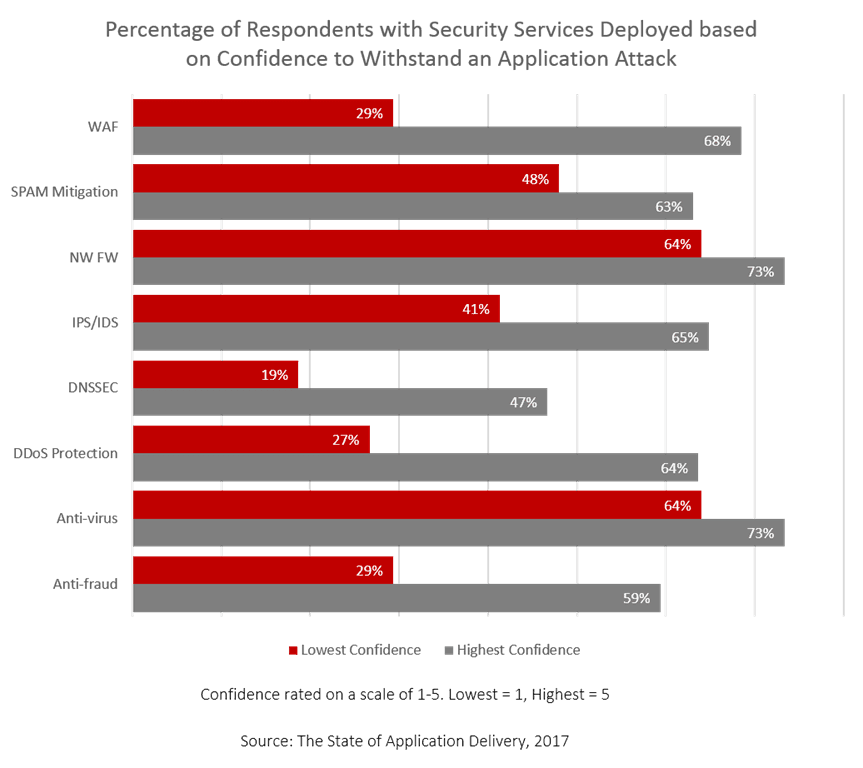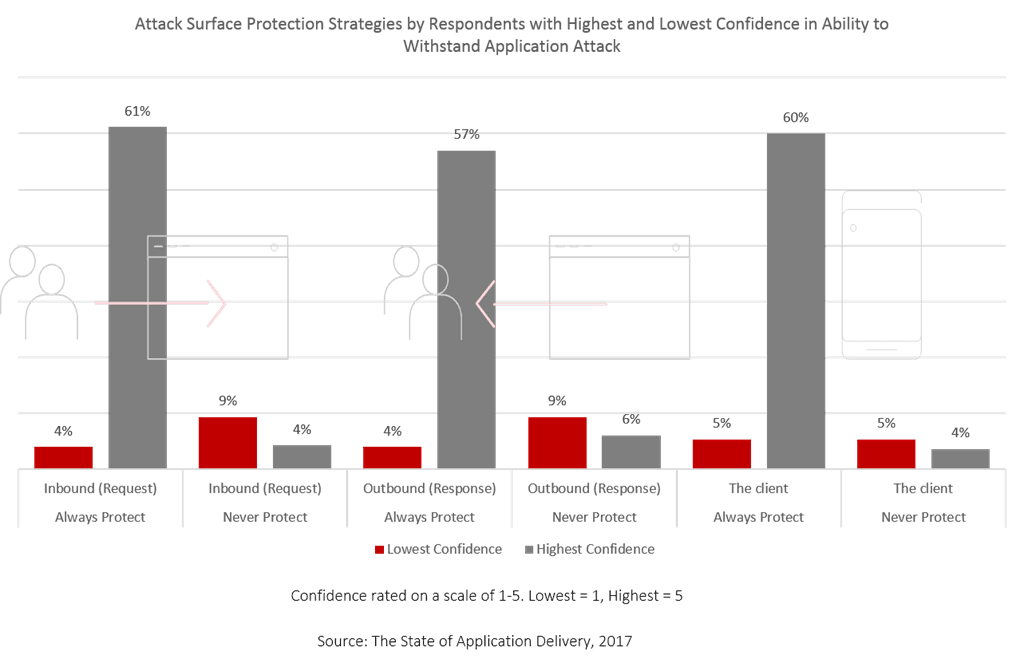Insights from the 2017 State of Application Delivery
Executives and security professionals alike are a pragmatic bunch, at least in terms of their confidence levels in withstanding application layer attacks.
Interestingly, neither group is likely to be pessimistic about their chances of battling off such attacks. Only 5% of each group in our State of Application Delivery survey had no confidence in their organizations’ ability to withstand an app layer attack. But that doesn’t mean they’re optimistic about their chances, either. Only 10% of security pros and 13% of execs were highly confident they can do battle with the bad guys and win at the app security game.

Indeed, their views were far more weighted somewhere in between, where pragmatism (realism) lies.
Forty percent (40%) of security folks were on the fence, neither more or less confident. A similar percentage of execs (37%) agreed. Which seems a reasonable stance to take these days. You might be confident you can withstand what you know, right now, is out there. But that’s the problem with security, the unknown is about to become a threat.
So what makes that 10% or so of security pros and executives so highly confident in their organization’s security posture? What is it they know that perhaps others don’t?

To find out, I started slicing and dicing data. We mentioned in the full report it appeared the deployment of a web application firewall and to a lesser extent, DDoS Protection, contributed to the confidence levels of respondents with respect to withstanding application layer attacks. But of course these aren’t the only two security services available; we’re tracking eight of them at this time.
It would seem reasonable, then, to assume that other security app services might have an impact on the confidence folks have in their organizations’ security posture. A quick dive into the data showed that might just be the case.
For each of the eight security services we are tracking, we found a higher percentage of services deployed by those with the greatest confidence. The difference in deployment status by confidence level of each service was generally dramatic. On average, respondents with the lowest confidence had an overall 24% lower deployment status of app security services. Fewer security services, lower confidence. Coincidence? I don’t think so.
But it’s not just deploying security services that might contribute positively (or negatively) to confidence folks can withstand an app layer attack. How you employ those app services in the service of securing apps matters, too.

Every year we’ve asked folks how they’re protecting apps. We identify three primary attack surfaces in need of protection: the client, the request, and the response. That’s because each offers a unique point in time with varying security tactics (and thus services) to better secure and defend apps and their valuable data. We ask respondents to describe how consistently they apply security policies to each of the three surfaces: always, never, or sometimes. At this point, I’m sure no one will be surprised to learn that folks with the highest confidence always protect all three surfaces. And conversely, those with the lowest tend to never protect any of the surfaces.
Obviously this isn’t the only factor that plays into confidence level. A small percentage of folks with the lowest confidence always protect these attack surfaces. And conversely, some with the highest confidence never protect these surfaces. The fact that folks with the lowest confidence must sometimes protect these surfaces says it’s a contributing factor, but certainly not the only one or there’d be a higher correlation between never protecting surfaces and the lowest confidence.
Still, more than half of those with the highest confidence always protect the client (60%), the request (61%), and the response (57%).
Coincidence? Again, I don’t think so.
Of course we can’t draw a causal relationship between the deployment and application of security app services and confidence levels, but we can clearly see there is a correlation between them.
IT pros with the highest confidence in their ability to withstand application layer attacks are more likely to deploy security app services and proactively protect all three attack surfaces than their more pessimistic counterparts. Something to consider if you’re feeling a bit “meh” about your chances to defend against whatever tomorrow might bring.
About the Author

Related Blog Posts

AppViewX + F5: Automating and orchestrating app delivery
As an F5 ADSP Select partner, AppViewX works with F5 to deliver a centralized orchestration solution to manage app services across distributed environments.

Build a quantum-safe backbone for AI with F5 and NetApp
By deploying F5 and NetApp solutions, enterprises can meet the demands of AI workloads, while preparing for a quantum future.

F5 ADSP Partner Program streamlines adoption of F5 platform
The new F5 ADSP Partner Program creates a dynamic ecosystem that drives growth and success for our partners and customers.
F5 NGINX Gateway Fabric is a certified solution for Red Hat OpenShift
F5 collaborates with Red Hat to deliver a solution that combines the high-performance app delivery of F5 NGINX with Red Hat OpenShift’s enterprise Kubernetes capabilities.
F5 Silverline Mitigates Record-Breaking DDoS Attacks
Malicious attacks are increasing in scale and complexity, threatening to overwhelm and breach the internal resources of businesses globally. Often, these attacks combine high-volume traffic with stealthy, low-and-slow, application-targeted attack techniques, powered by either automated botnets or human-driven tools.
Phishing Attacks Soar 220% During COVID-19 Peak as Cybercriminal Opportunism Intensifies
David Warburton, author of the F5 Labs 2020 Phishing and Fraud Report, describes how fraudsters are adapting to the pandemic and maps out the trends ahead in this video, with summary comments.
